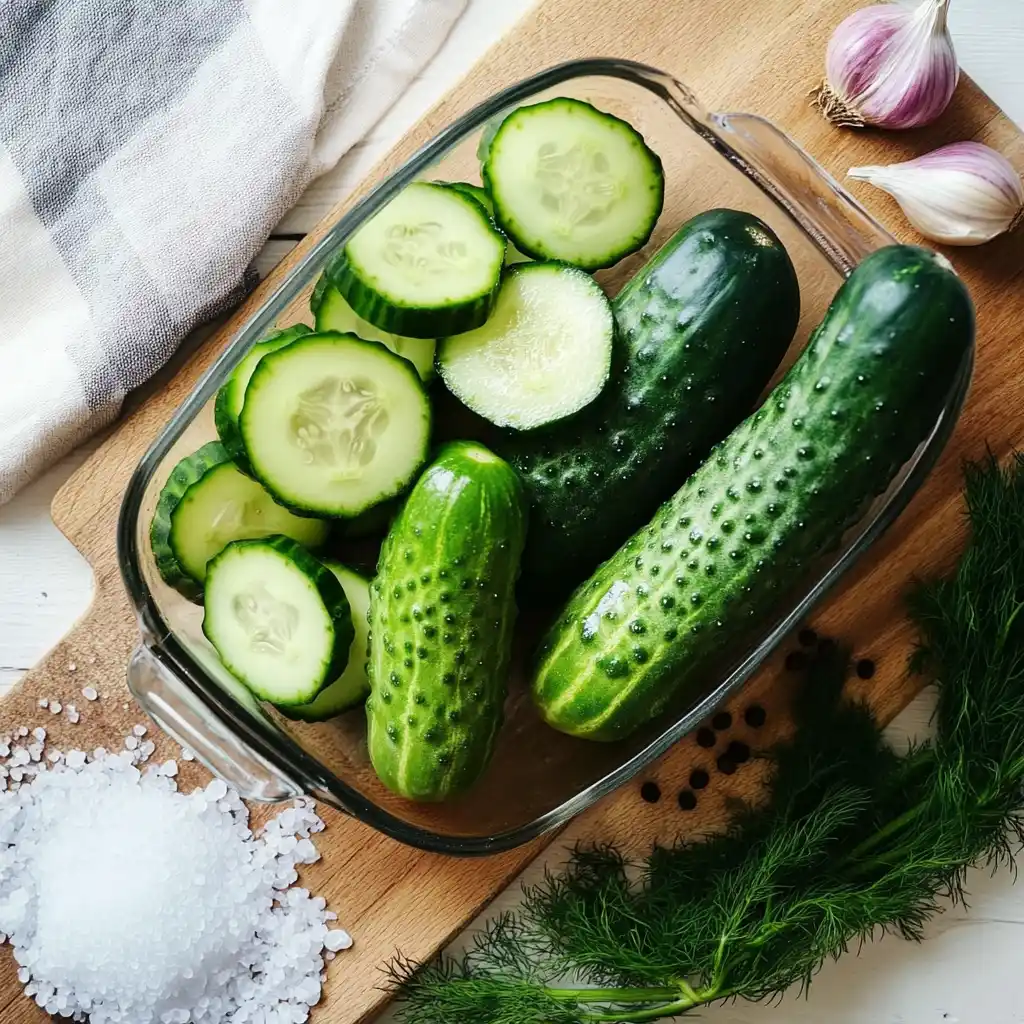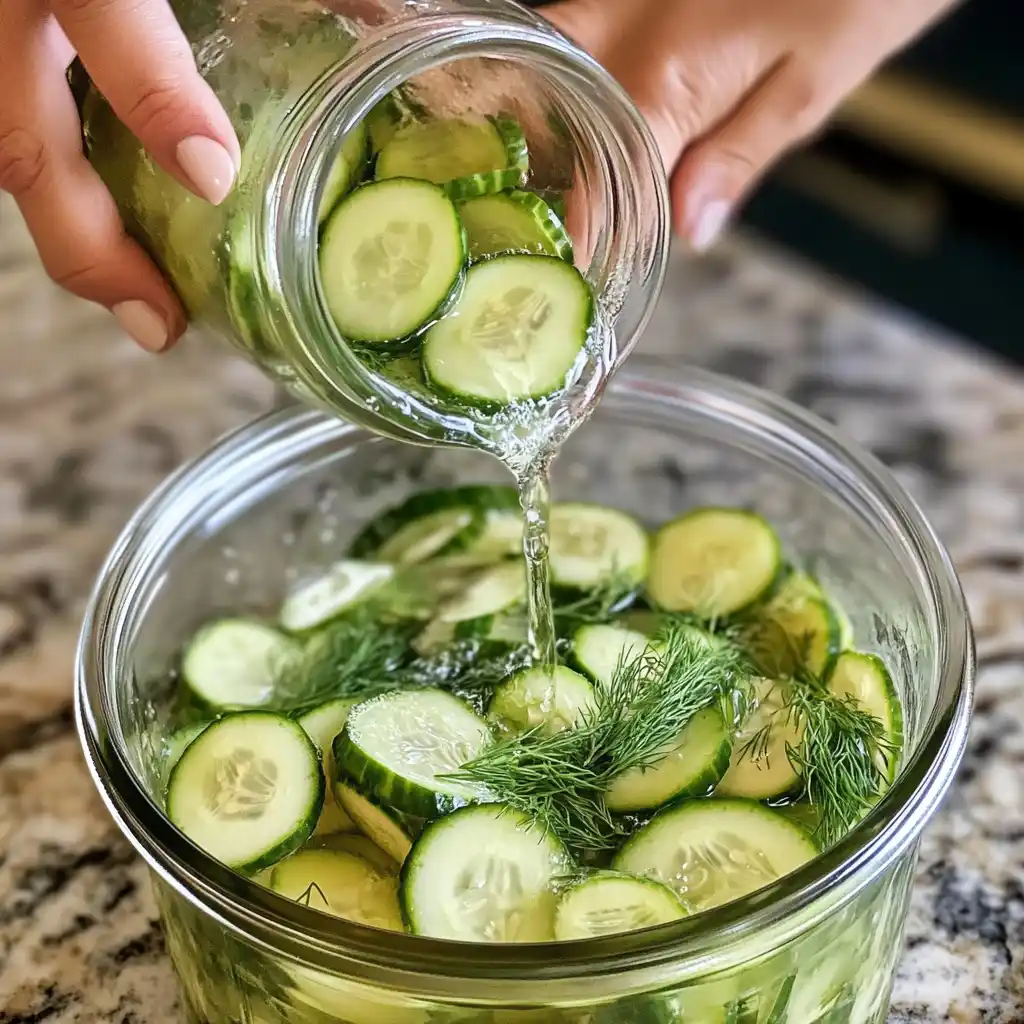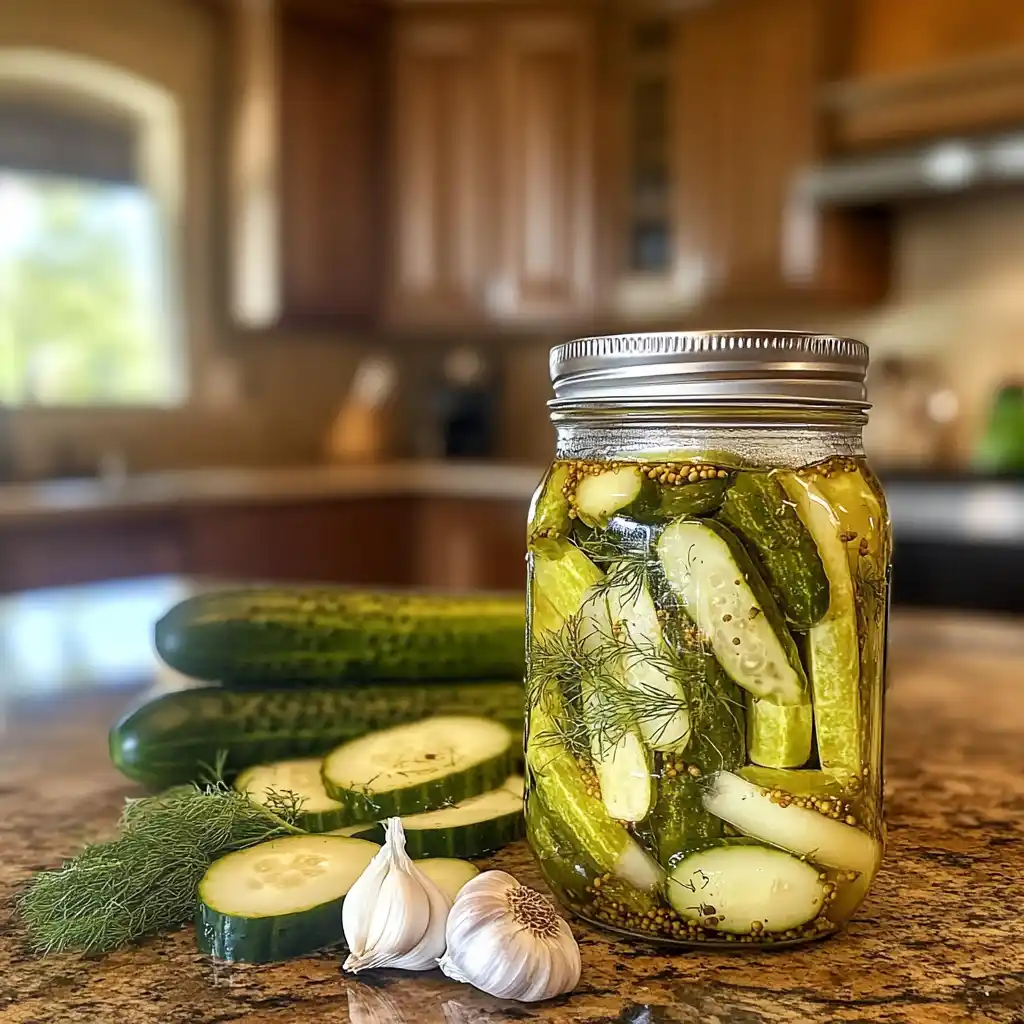Making refrigerator dill pickles at home is easier than you think—and the results are far superior to anything you’ll find on store shelves. Whether you’re new to pickling or a seasoned pro, this guide walks you through everything you need to know to make fresh, crunchy, flavorful pickles without boiling jars or using any special canning equipment.
In this article, we’ll explore how to choose the best ingredients, create a perfectly balanced brine, and store your pickles for long-lasting freshness. You’ll learn how long refrigerator dill pickles last, whether or not you need to boil the brine, what type of vinegar works best, and other tips to avoid soggy or bland results. We’ll also tackle customization ideas for flavor, proper jar techniques, and creative ways to enjoy your homemade pickles.
Looking for inspiration? Try our expert guide on delicious pickled sausage—a tangy Southern treat to explore more brine-based snacks.
Now let’s dive into what makes these pickles so special and why they deserve a spot in your fridge year-round.
Table of Contents
Introduction to Refrigerator Dill Pickles
What Are Refrigerator Dill Pickles?
Refrigerator dill pickles are cucumbers preserved in a flavorful brine of vinegar, water, salt, and fresh herbs like dill. Unlike traditional pickles that require hot water canning, these are simply prepared, sealed in jars, and stored in the refrigerator. They’re a quick-pickle method that skips the heat and delivers bright, fresh flavor in as little as 24 to 48 hours.
This technique is ideal for beginners, busy cooks, or anyone who wants a crisp, homemade pickle without all the fuss. The cool storage not only helps preserve that signature snap, but it also allows the flavors to infuse more slowly, making the pickles taste fresher and more vibrant.
Why They’re Better Than Store-Bought
Let’s face it: store-bought pickles can be mushy, overly sour, or packed with preservatives. When you make refrigerator dill pickles at home, you control everything—texture, flavor, spice level, and ingredient quality.
Here’s why homemade refrigerator pickles stand out:
- No artificial preservatives or colorings
- Customizable taste: Add more garlic, spice, or sweetness
- Crunchier texture thanks to fresh cucumbers and cold brining
- Less sodium than commercial brands
- Ready in 1–2 days, not weeks
Ingredients That Make the Best Refrigerator Dill Pickles
Key Ingredients: Cucumbers, Vinegar, and Dill
The magic of great refrigerator dill pickles starts with simple, quality ingredients. Each one plays a critical role in flavor, texture, and shelf life.
Cucumbers
Use Kirby cucumbers or other pickling varieties. They’re short, firm, and known for holding their crunch. Avoid slicing cucumbers or those with thin skins—they tend to get soggy quickly.
Vinegar
This is your preservation powerhouse. Use distilled white vinegar for a sharp, classic taste, or try apple cider vinegar for a hint of sweetness and depth. The vinegar-to-water ratio should be at least 1:1 to ensure safety and strong flavor.
Fresh Dill
Dill is what gives this pickle its name and distinct herbaceous punch. Use fresh dill sprigs if possible, or dill heads (which include the stem and seeds) for more flavor.
Water & Salt
Always use filtered water and non-iodized salt like pickling salt or sea salt. Table salt may cause cloudiness and off flavors.
Basic Refrigerator Dill Pickle Brine Recipe
| Ingredient | Amount |
|---|---|
| Water | 1 cup |
| Vinegar (white or ACV) | 1 cup |
| Pickling salt | 1 tbsp |
| Sugar (optional) | 1 tsp |
| Garlic cloves | 2–3, smashed |
| Fresh dill | 3–5 sprigs |
| Peppercorns | 1 tsp (optional) |

Want to compare brining styles? Discover great ideas like this three-bean salad recipe that also balances acidity and flavor beautifully.
Optional Add-ins for Extra Flavor: Garlic, Peppercorns, and More
Once you’ve mastered the base recipe, it’s time to play with flavor. The beauty of refrigerator pickles is how easily they adapt to your preferences.
Popular Add-ins:
- Garlic – Adds savory depth. Smash or slice it to release the oils.
- Mustard seeds – For a slightly spicy, earthy tone.
- Peppercorns – Add bite without heat.
- Bay leaves – Impart subtle herbal notes.
- Red chili flakes – Turn up the heat for spicy pickles.
- Coriander or dill seeds – Layer in warmth and complexity.
Pro Tip: Always add dry spices to the bottom of the jar before packing in the cucumbers. This helps release the flavors more evenly into the brine.
Step-by-Step Guide to Making Refrigerator Dill Pickles
Prepping Your Cucumbers for Crispness
To get that irresistible crunch in your refrigerator dill pickles, cucumber prep is non-negotiable. Even with the best brine, soft or overripe cucumbers will sabotage your efforts.
Follow these steps to prepare cucumbers properly:
- Wash thoroughly: Scrub off any dirt, wax, or residue.
- Trim the ends: Especially the blossom end—it contains enzymes that can soften the pickles.
- Dry completely: Moisture weakens the brine and encourages spoilage.
- Slice strategically: Cut into spears, chips, or leave whole (smaller ones). Thinner slices pickle faster but may lose crunch.
Optional: Soak cucumbers in an ice water bath for 1–2 hours before pickling. This step tightens their cell walls for maximum crispness.
Making the Brine: Boiling or Not Boiling?
This is one of the most asked questions—and rightly so. Do you need to boil the brine for refrigerator dill pickles?
Short answer: It depends on your texture and flavor preferences.
Boiling Pros:
- Dissolves salt and sugar faster
- Helps draw out flavors from spices
- Slightly softens cucumbers (good for certain recipes)
Boiling Cons:
- May reduce crunch
- Takes more time
No-Boil Method:
- Combine water, vinegar, salt, and sugar in a jar
- Stir vigorously or shake with a lid until dissolved
- Pour directly over cucumbers

Pro Tip: If you’re using garlic or whole spices, warm the brine slightly (not boil) to help release their oils, then cool it before pouring.
| Brining Method | Best For | Crunch Factor |
|---|---|---|
| Boiling | Intense flavor, faster results | Medium |
| No-Boil (Cold Brine) | Maximum crunch, fresh flavor | High |
Best Vinegars for Refrigerator Dill Pickles
White Vinegar vs Apple Cider Vinegar
Choosing the right vinegar is crucial for flavor, acidity, and shelf life in refrigerator dill pickles. The vinegar doesn’t just provide the pickle’s signature tang—it also preserves the cucumbers and helps inhibit bacterial growth.
White Distilled Vinegar
This is the go-to choice for classic dill pickles. It’s crystal clear, sharply acidic (usually 5% acetic acid), and has a clean, neutral flavor that lets dill, garlic, and spice shine through.
Pros:
- Inexpensive and widely available
- Maintains color of pickles and brine
- Bold, sharp tang
- Ideal for traditionalists
Apple Cider Vinegar (ACV)
ACV brings a fruity depth and subtle sweetness. It’s a favorite among those who want more complexity in their pickle brine.
Pros:
- Milder acidity
- Adds unique flavor layer
- Works great in sweeter or spiced pickles
Note: Always check that your vinegar is at least 5% acidity—this ensures proper preservation even in refrigerator pickling.
| Vinegar Type | Flavor Profile | Appearance | Best Use Case |
|---|---|---|---|
| White Distilled | Sharp & clean | Clear | Classic dill pickles |
| Apple Cider Vinegar | Fruity & mild | Amber | Sweet or spicy variations |
How Vinegar Affects Flavor and Preservation
Vinegar isn’t just for taste—it’s the cornerstone of safe preservation in refrigerator pickles. The acid content lowers pH, which helps prevent the growth of bacteria and mold.
The ideal vinegar-to-water ratio is usually 1:1, but you can use more vinegar if you like a punchier taste or plan to store your pickles longer.
Acid Level Impacts:
- Too little vinegar = weak flavor and risk of spoilage
- Too much vinegar = overpowering tang and soft texture
For the most balanced flavor:
- Combine 1 cup water + 1 cup vinegar + 1 tbsp salt
- Add sugar only if you want a milder taste
Pro Tip: Mix different vinegars (e.g., ¾ white vinegar + ¼ ACV) for a custom taste that’s bold yet smooth.
Jar It Right: Storing Refrigerator Dill Pickles the Smart Way
Why the Right Jar Matters for Refrigerator Dill Pickles
If you want your refrigerator dill pickles to stay fresh, crunchy, and safe to eat, you need to pick the right storage container. The jar you use directly impacts the texture and shelf life of your pickles. The wrong jar can lead to leaks, poor seals, and even contamination.
Mason jars are the most popular choice for good reason. They’re durable, reusable, and seal tightly—ideal for preserving your homemade pickles in the fridge. But they’re not your only option.
Best Jars for Refrigerator Dill Pickles:
- Mason Jars (Glass): They’re airtight, transparent, and made to handle acidic brines. Pick wide-mouth versions for easy packing.
- Glass Storage Jars with Rubber Gaskets: Great for modern kitchens, these jars offer tight seals and allow for quick access.
- Plastic Food-Grade Containers: These work in a pinch but are less ideal. Acid from the pickle brine can stain or degrade plastic over time.
- Upcycled Pickle Jars: Eco-friendly and functional—but test the lid for a proper seal and make sure there are no odors.
| Container Type | Benefits | Downsides |
|---|---|---|
| Mason Jars | Durable, ideal for pickling | Can shatter if mishandled |
| Glass Storage Jars | Stylish, easy to open | Some lids don’t seal tightly |
| Plastic Containers | Lightweight, accessible | May absorb vinegar or smell |
How to Prep Jars for Refrigerator Dill Pickles
Even though refrigerator pickles aren’t processed with heat like canned pickles, clean jars are still a must. Dirty or contaminated jars can ruin your brine and spoil your pickles.
Steps to Sanitize Your Pickle Jars:
- Wash jars with hot, soapy water and rinse thoroughly.
- For extra safety, boil jars in water for 10 minutes or run them through a dishwasher on the sanitize setting.
- Dry completely before packing in cucumbers and brine.
Important: Don’t forget to sanitize the lids, too. Avoid using damaged or rusted lids, especially if you’re reusing jars.
Storage Tips for Refrigerator Dill Pickles:
- Always store pickles in the coldest part of your refrigerator—not the door
- Leave about ½ inch headspace to prevent overflow during fermentation
- Use clean tongs or utensils when removing pickles to avoid introducing bacteria
- Keep jars tightly sealed to lock in that bold dill flavor
How Long Do Refrigerator Dill Pickles Last?
Proper Storage Tips for Maximum Shelf Life
One of the biggest perks of refrigerator dill pickles is their extended shelf life—without the need for canning. But even though they’re simple to make, how you store them makes all the difference in how long they stay fresh, crisp, and safe to eat.
In general, homemade refrigerator dill pickles last up to 2 months in the fridge when properly stored. However, they’re often at their crunchiest and most flavorful within the first 2 to 4 weeks.
Tips to Make Refrigerator Dill Pickles Last Longer:
- Always use clean, airtight jars to prevent exposure to air and bacteria.
- Store in the coldest part of your fridge—not the door. Temperature fluctuations reduce shelf life.
- Keep pickles fully submerged in the brine to prevent mold and spoilage.
- Avoid contamination: Use clean tongs, not your fingers, when removing pickles.
| Storage Factor | Effect on Shelf Life |
|---|---|
| Clean, airtight jars | Prevent spoilage and mold |
| Cold storage | Slows bacterial growth |
| Full brine coverage | Preserves texture and flavor |
| Clean handling | Avoids contamination risks |
Signs Your Pickles Have Gone Bad
Even properly stored refrigerator dill pickles can go bad if the ingredients weren’t fresh or if contamination occurred during prep.
Warning Signs to Look For:
- Cloudy or moldy brine (some cloudiness from garlic is normal; mold is not)
- Off smells like sour rot, ammonia, or yeast
- Change in texture: overly soft or slimy pickles
- Discoloration or brine leaking from the lid
Don’t miss our insights on how to make pickled pie pizza for a zesty treat—another fun way to use preserved ingredients.
If you notice any of these signs, discard the pickles immediately. When in doubt, toss them out.
Flavor Variations and Customizations
Spicy Dill Pickles: Jalapeño and Chili Options
If you’re craving a little heat with your crunch, turning your refrigerator dill pickles into a spicy snack is simple and satisfying. Heat lovers will appreciate the kick from jalapeños, chili flakes, or even fresh habaneros.
Popular Ways to Spice Up Your Refrigerator Dill Pickles:
- Jalapeño slices – Add 2–3 slices per jar for mild heat
- Crushed red pepper flakes – Start with ½ teaspoon per jar and adjust to taste
- Fresh chili peppers – Thai bird chilies or serranos bring bold spice
- Hot sauce – A dash in the brine gives a background burn
These spicy additions work best when added directly to the brine, allowing the heat to infuse into every bite. For balanced flavor, pair heat with extra garlic and mustard seeds.
| Spice Ingredient | Heat Level | Flavor Profile |
|---|---|---|
| Jalapeño | Mild | Bright, peppery |
| Red Chili Flakes | Medium | Sharp, warm |
| Serrano Pepper | Medium-Hot | Clean, grassy heat |
| Habanero | High | Fruity, intense |
Sweet and Tangy Pickles: A Twist on Tradition
Not every dill pickle has to be all brine and bite. If you love a contrast of flavors, try sweet and tangy refrigerator dill pickles. By adding just a touch of sugar to your brine, you can strike a balance that’s crowd-pleasing and totally addictive.
How to Add Sweetness:
- Use 1 to 2 tablespoons of sugar per 2-cup brine mix
- Combine with apple cider vinegar for mellow tartness
- Balance with extra garlic or black peppercorns to keep the dill flavor pronounced
Flavor Boosters for Sweet Dill Pickles:
- Cinnamon sticks – A warm hint that pairs surprisingly well with dill
- Whole cloves – Earthy sweetness in moderation
- Allspice berries – Add depth and complexity to sweet brines
- Fresh herbs – Try a pinch of tarragon or thyme for herbal balance
Sweet pickles are perfect for:
- Sandwiches
- Charcuterie boards
- Pickleback shots (yep, they’re a thing!)
Whether you’re going bold and spicy or sweet and herby, refrigerator dill pickles are endlessly customizable—and the variations are only limited by your taste and imagination.
Troubleshooting Common Pickling Mistakes
Why Are My Refrigerator Dill Pickles Mushy?
Few things are more disappointing than biting into a soggy pickle. If your refrigerator dill pickles come out soft or limp, it’s likely due to one of these common mistakes.
Causes of Mushy Refrigerator Pickles:
- Using slicing cucumbers instead of pickling cucumbers like Kirbys
- Skipping the blossom-end trim, which contains enzymes that break down firmness
- Brining while cucumbers are warm or overripe
- Brine too hot when poured over cucumbers
- Incorrect storage temperature — the door of the fridge fluctuates too much
How to Keep Pickles Crunchy:
- Use firm, fresh cucumbers, and soak them in ice water for 1–2 hours before pickling
- Always trim 1/16″ off the blossom end of each cucumber
- Cool the brine to room temperature before pouring
- Add grape leaves, tannin-rich tea leaves, or alum (optional but effective for firmness)
Fixing Cloudy Brine or Off Smells
It’s normal to worry when your brine doesn’t look crystal clear. But not all cloudiness or odor means your pickles are bad.
When Cloudy Brine Is Okay:
- Caused by fresh garlic, mustard seeds, or apple cider vinegar
- Natural oils and sediment from spices may collect over time
- Pickles are still safe if the smell is fresh and pickly
When Cloudy Brine Means Trouble:
- Foul or yeasty smell (not vinegary)
- Floating white mold or film on the surface
- Brine turning murky with slimy cucumbers
What to Do:
- If unsure, toss the jar. Better safe than sorry.
- Avoid contamination by using sterilized jars and clean utensils
- Store pickles at consistent cold temperatures away from light and heat
Troubleshooting isn’t just about saving a batch—it’s about mastering your method. Once you understand these signs, you’ll be more confident in every jar you make.
Serving Ideas and Creative Uses for Dill Pickles
Recipes That Use Refrigerator Dill Pickles
Your homemade refrigerator dill pickles deserve more than just a quick snack moment straight from the jar. These crisp, tangy slices can elevate countless dishes with their sharp, herbaceous bite. From sandwiches to party dips, their flavor and crunch add instant zing.
Delicious Ways to Use Dill Pickles:
- Classic Pickle Sandwiches: Add slices to burgers, subs, or grilled cheese
- Deviled Eggs with a Twist: Finely chop pickles into the yolk mixture
- Tuna or Chicken Salad Boost: Pickles add the perfect acidic punch
- Potato or Pasta Salad: Use chopped pickles to add contrast to creamy textures
- Pickle-Brined Fried Chicken: Soak chicken in leftover brine for juicy, flavorful results
Quick Pickle Dip Recipe:
Mix cream cheese, chopped dill pickles, shredded cheddar, and a splash of brine. Perfect for crackers or pretzel dippers!
Fun and Unique Ways to Serve Homemade Pickles
Refrigerator dill pickles can shine far beyond side dishes. With a little creativity, they become the centerpiece of party trays, cocktail hour, or even savory desserts.
Creative Serving Ideas:
- Pickle Skewers: Alternate pickles, cheese cubes, olives, and meats for easy appetizers
- Pickle Ice Cubes: Freeze brine with sliced pickles for Bloody Marys or picklebacks
- Deep-Fried Dill Pickles: Coat in seasoned breadcrumbs and fry until crispy
- Pickle Pizza: Add thinly sliced pickles to white sauce pizza with mozzarella and garlic
- Pickle Relish: Blend with onions, mustard seed, and sugar for a sweet-savory condiment

Entertaining with Pickles:
Add them to a DIY pickle board with a mix of spicy, sweet, and classic varieties—plus dips and breads for a full experience.
With so many ways to serve them, your refrigerator dill pickles will never sit forgotten at the back of the fridge again.
FAQs About Refrigerator Dill Pickles
How long do refrigerator dill pickles last?
Refrigerator dill pickles can last up to 2 months when stored properly in an airtight jar in the coldest part of the fridge. They’re at their peak flavor and crunch within the first 2 to 4 weeks. Be sure to keep the cucumbers fully submerged in brine and avoid introducing contaminants like dirty utensils to extend their shelf life.
Do you have to boil brine for refrigerator pickles?
No, you don’t have to boil the brine. Many refrigerator dill pickle recipes use a no-boil method where you mix vinegar, water, salt, and sugar cold. However, slightly heating the brine can help dissolve salt faster and extract more flavor from spices and garlic. Just let it cool before pouring it over cucumbers to preserve their crunch.
What is the best vinegar to use for refrigerator pickles?
The best vinegar depends on the flavor profile you’re after. Distilled white vinegar is the classic choice—it’s sharp, clean, and colorless. For a sweeter or more complex flavor, use apple cider vinegar. Always make sure your vinegar has at least 5% acidity to ensure proper preservation.
Should you refrigerate dill pickles?
Yes, refrigerator dill pickles must be kept cold at all times. Unlike canned pickles, these are not shelf-stable. The cold temperature slows bacterial growth and helps maintain crispness. Store them in the back of your fridge, not in the door, where temperatures fluctuate more.
Conclusion: Make Refrigerator Dill Pickles Like a Pro
Whether you’re a first-time pickler or someone looking to skip the canning chaos, refrigerator dill pickles are your gateway to fresh, crunchy, and flavor-packed results without the fuss. With just a few quality ingredients—like cucumbers, vinegar, dill, and salt—you can create jars of bold, herbaceous goodness in minutes. No hot water bath. No special gear. Just crisp perfection every time.
You’ve learned how to choose the right cucumbers, customize your brine with spice or sweetness, and avoid common mistakes that lead to mushy or off-tasting pickles. From jalapeño heat to sweet and tangy twists, the customization options are endless. And the best part? These pickles are ready to enjoy in just 24 to 48 hours and last for weeks in the fridge.
Check out this creative birthday cake for men guide if you’re planning a unique celebration with homemade foods.
Love visual inspiration? Follow us on Pinterest for more homemade pickle recipes, easy food hacks, and kitchen-friendly guides.
So go ahead—gather your jars, grab some fresh cucumbers, and start your next crave-worthy batch today.
Print
Refrigerator Dill Pickles
These crunchy, tangy refrigerator dill pickles are easy to make, need no canning equipment, and are ready in just a couple of days. Perfect for snack time, sandwiches, or customizing with your favorite spices.
- Total Time: 20 minutes
- Yield: 2 pint jars 1x
Ingredients
-
1 cup water
-
1 cup white or apple cider vinegar (5% acidity)
-
1 tbsp pickling salt
-
1 tsp sugar (optional)
-
2–3 garlic cloves, smashed
-
3–5 sprigs fresh dill
-
1 tsp peppercorns (optional)
-
Kirby cucumbers or pickling cucumbers
-
Optional add-ins: mustard seeds, red chili flakes, coriander seeds, bay leaves
Instructions
-
Wash cucumbers thoroughly and trim off blossom ends.
-
Slice cucumbers into spears, chips, or leave whole if small.
-
Optional: Soak cucumbers in ice water for 1–2 hours for maximum crunch.
-
Sterilize jars by washing with hot soapy water and drying completely.
-
Add dry spices and garlic to the bottom of jars.
-
Pack cucumbers tightly into jars.
-
In a bowl or saucepan, combine water, vinegar, salt, and sugar (if using).
-
Stir until salt dissolves. Slightly heat if needed, then cool before pouring.
-
Pour brine over cucumbers, ensuring they’re fully submerged.
-
Seal jars tightly and store in the back of the refrigerator.
-
Let pickles brine for at least 24–48 hours before eating.
-
Keep refrigerated and consume within 2 months.
Notes
Use only fresh, firm cucumbers like Kirbys for best texture. Always store pickles cold and use clean utensils to prevent contamination.
- Prep Time: 20 minutes
- Cook Time: 0 minutes
- Category: Condiment
- Method: No-Cook
- Cuisine: American
Nutrition
- Serving Size: 1 spear
- Calories: 5
- Sugar: 0g
- Sodium: 200mg
- Fat: 0g
- Saturated Fat: 0g
- Unsaturated Fat: 0g
- Trans Fat: 0g
- Carbohydrates: 1g
- Fiber: 0g
- Protein: 0g
- Cholesterol: 0mg
Keywords: refrigerator pickles, dill pickles, homemade pickles, easy pickling

